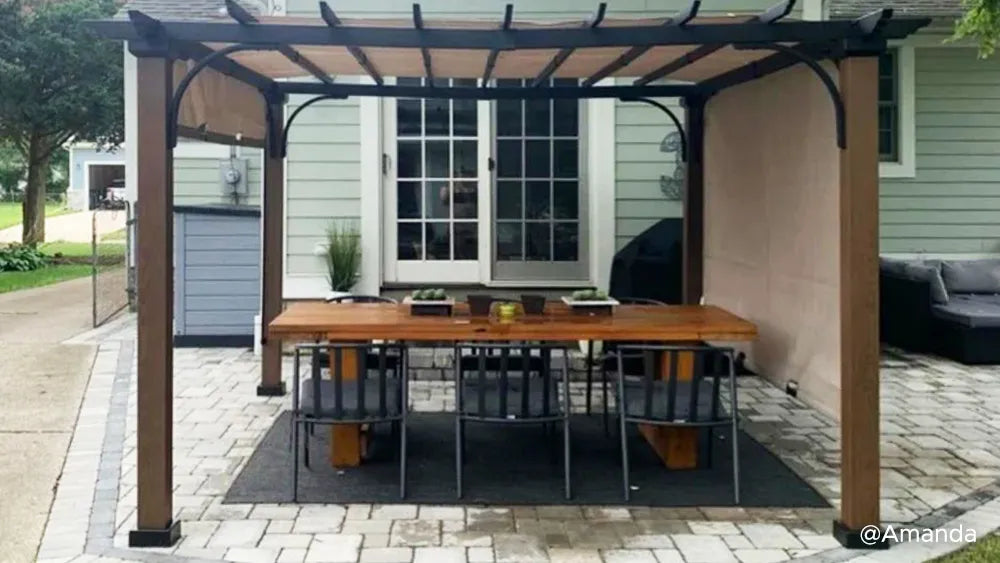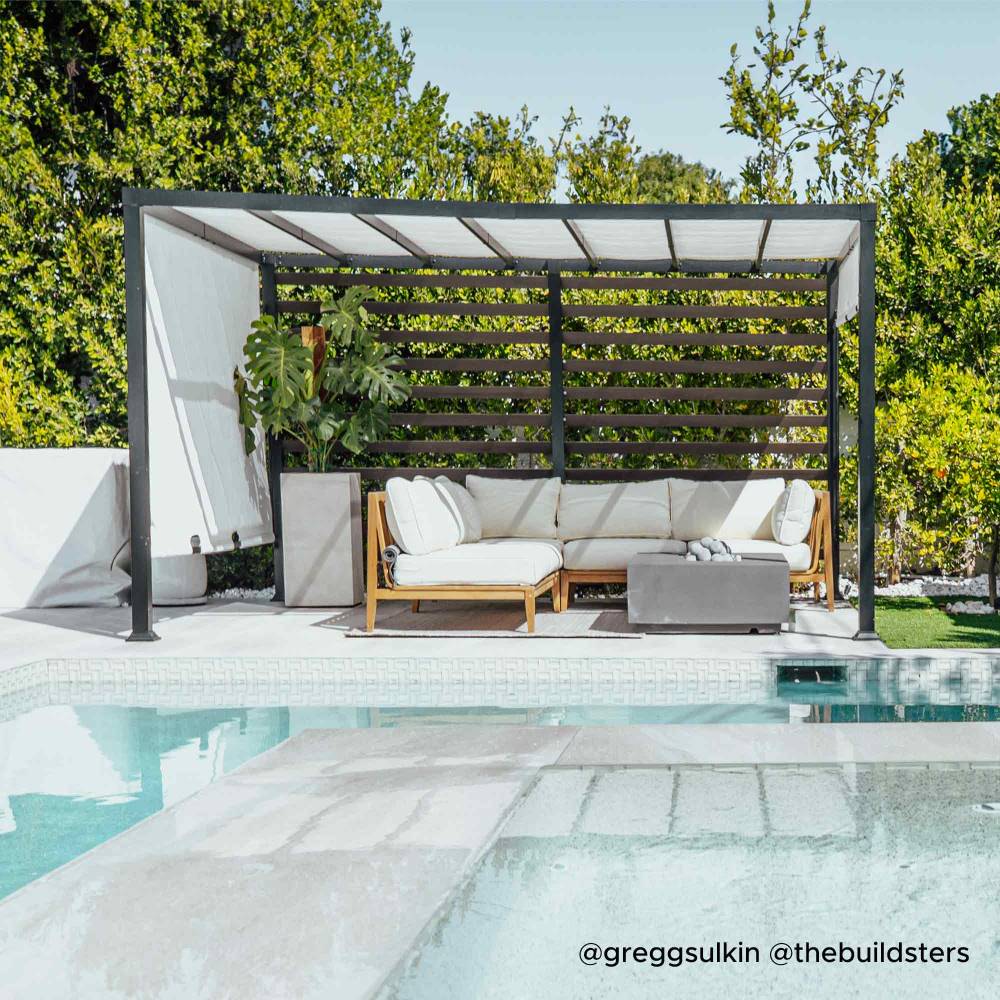Winter isn’t the enemy of your backyard — standing water is.
The most beautifully designed pergola can lose its strength long before spring simply because of one overlooked detail: drainage.
Snow melts, freezes again, expands, and seeps into hidden joints. Rain collects on flat canopies or beams and adds invisible weight. Over time, it’s not storms that destroy outdoor structures — it’s stagnation.
Understanding and managing drainage isn’t just a maintenance chore; it’s a design philosophy. A well-drained pergola doesn’t only survive winter — it thrives through it.
1. Why Water Is Winter’s Most Subtle Enemy
We often think of winter damage in terms of weight — the load of snow or pressure of ice. But what causes the real structural fatigue is the cycle of thawing and freezing.
Each melt sends moisture into micro-gaps in your pergola’s joints. When temperatures drop, that moisture freezes and expands, pushing materials apart millimeter by millimeter.
By spring, what began as minor seepage becomes visible cracking or corrosion.
A 12-foot pergola beam holding even 200 pounds of trapped water has already lost part of its load capacity. Multiply that across posts and canopy frames, and the structure is silently suffering.
Design insight: Drainage isn’t just about where the water goes — it’s about where it doesn’t stay.
2. The Climate Logic of Drainage
Winter brings two things that test every outdoor structure: slow evaporation and low sunlight.
In summer, moisture dries quickly. In winter, it lingers — creating constant dampness around bolts, beams, and fabric.
That’s why pergola drainage should be designed according to climate rhythm, not only rainfall totals.
A cold, dry winter may require angled beams for quick runoff. A wet, coastal region might benefit from hidden downspouts in the posts.
Good winter drainage systems don’t fight nature — they cooperate with it.
They channel gravity, guide water, and let the elements clean themselves.
Rule of thumb: For every 10 feet of roof span, allow at least a one-inch pitch to ensure smooth runoff, even in freezing conditions.
3. Material Behavior: How Wood and Metal React Differently
Every pergola material has its own conversation with water — some absorb, others resist, but none ignore it.
Wood Pergolas
Wood breathes. It absorbs air moisture, then contracts when temperatures drop.
Without proper sealing or slope, melting snow seeps into the grain and re-freezes overnight, causing hairline splits.
A sealed wood pergola allows water to roll off smoothly, while untreated cedar or pine will eventually expand, crack, and invite mildew.
Metal Pergolas
Steel or aluminum pergolas often feature internal channels for drainage — but when debris clogs them, they trap condensation. In freezing weather, this trapped water becomes ice plugs, adding pressure to joints.
For long-term resilience, choose powder-coated steel or aluminum, and inspect drainage holes before the first frost.
SUNJOY Tip: Before winter, pour a small bucket of water on the roof. Watch where it flows. If it pools, it’s time to clean or adjust slope.
4. Design for Flow, Not Just Form
Most pergolas are designed for aesthetics first — symmetry, color, shadow play. But the best winterproof designs think like engineers.
Here’s how modern drainage works in functional pergolas:
- Hidden Gutter Systems: Channels built into roof frames to redirect water through hollow posts.
- Integrated Spouts: Small outlets at beam ends that control flow and prevent streaking down sides.
- Permeable Bases: Stone, gravel, or slatted flooring that absorbs runoff before it puddles.
- Canopy Tension Systems: Slightly arched or taut canopies that prevent sagging under snow weight.
Consider how the SUNJOY 9.5x11 Metal Arched Pergola uses curvature not just for beauty but for water control. The gentle arch helps rainwater slide naturally while maintaining structural balance.
Design philosophy: If your pergola’s water flow feels invisible, it’s probably perfect.
5. Harmony Between Fire and Water
One of the most overlooked drainage details appears when homeowners add warmth.
Pairing a pergola with a fireplace or fire pit can create thermal asymmetry — one side melts snow faster than the other, leading to uneven pooling.
To maintain stability and safety:
- Keep fire features slightly offset from posts or canopy edges.
- Install a gentle slope away from heating zones.
- Use pavers or gravel below to promote evaporation and prevent ice rings.
For example, the SUNJOY 48-Inch Wood Burning Stone Fireplace becomes even more efficient when surrounded by permeable patio flooring. Its warmth creates airflow that accelerates drying — a design symbiosis of heat and drainage.
Aesthetic balance: The best winter patios integrate both fire and water management — one creates comfort, the other ensures longevity.
6. The Science of Silent Protection
Proper drainage is the most invisible upgrade you can make to your pergola, yet it offers the highest long-term return.
Reduces freeze-thaw stress on joints.
Prevents corrosion, peeling, and rot.
Extends the lifespan of finishes and sealants.
Protects flooring and foundations from frost heave.
Keeps your pergola looking “new” far beyond its warranty.
Think of drainage like the circulatory system of your backyard architecture — unseen but vital. When water can flow freely, your pergola’s materials stay strong, your base stays level, and your outdoor space remains functional even during storms.
7. Merging Utility and Beauty
Drainage design isn’t limited to gutters and holes — it can become part of your aesthetic language. Rain chains, sloped beams, and channel cutouts can complement your pergola’s geometry, creating a sense of movement and rhythm.
A minimalist metal pergola might feature sleek integrated channels, while a wood pergola could use exposed copper downspouts as decorative accents.
When form and function align, even runoff can look intentional.
Style insight: Winter water doesn’t have to be hidden — it can become choreography.
8. Preparing Before the Freeze
Before the first frost, run this quick winter inspection checklist:
|
Step |
Action |
Why It Matters |
|
1 |
Clear canopy and beams of debris |
Prevents blockages and pooling |
|
2 |
Check gutter outlets and post holes |
Ensures water exits freely |
|
3 |
Re-seal wood or inspect metal coatings |
Keeps moisture out of joints |
|
4 |
Verify slope and flow direction |
Avoids water collecting near base |
|
5 |
Inspect ground drainage |
Protects foundations and flooring |
Ten minutes of maintenance can prevent hundreds in repairs.
9. Beyond the Pergola: Ecosystem Thinking
Proper drainage shouldn’t stop at your pergola — it should integrate with your whole outdoor layout.
Your gazebo, carport, or fireplace area all influence how water moves across your yard. A pergola with efficient runoff can divert excess meltwater to garden zones or dry wells, turning potential waste into landscape benefit.
When you treat your backyard like an ecosystem, drainage becomes a design connector — linking every structure in balance.
Holistic idea: Water flow is the choreography of your backyard. Plan it like you’d plan architecture — deliberately and beautifully.
Final Reflection: Winter-Proof Is Future-Proof
A pergola that manages water well doesn’t just survive winter — it becomes part of it. Each droplet that flows correctly down its beam is a sign of design done right.
When you step outside on a cold morning and see water gliding cleanly off your pergola roof instead of pooling at its base, you’ll understand: Good drainage is invisible elegance.
It’s the reason your backyard will look as perfect in January as it does in June — and why your pergola will still stand strong many winters from now.






